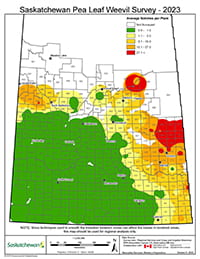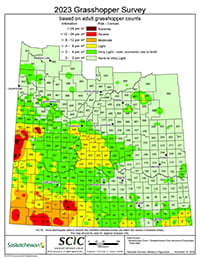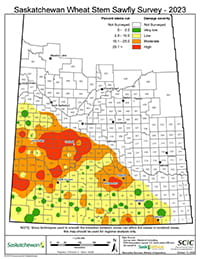By Carter Peru, PAg, Integrated Pest Management Specialist, Crops and Irrigation Branch, Regina
The 2023 growing season posed many challenges for farmers, some of which included high insect pest pressure. Several insect surveys took place in 2023 with populations varying significantly depending on the insect species surveyed. This article provides a brief overview of the surveys that were conducted.
Although fieldwork for these surveys is complete, lab work for some surveys continues into winter and results have yet to be finalized.
Diamondback moth is a pest of concern in many brassicaceous crops, including canola and mustard. The survey used pheromone traps that attract male moths. For 2023, the monitoring period was for a period of 12 weeks from early May to late August; traps began to capture male moths (adult stage) in early May and weekly catches increased until late June. Although a secondary, much larger peak was observed in late July, overall diamondback moth counts were low throughout the province.
During the monitoring period, traps were examined weekly and the number of Diamondback moths caught was reported by co-operators.
Traps are placed early in the growing season since the main objective of this survey is to detect when migratory populations arrive from the south (i.e., the U.S. and Mexico). The population of Diamondback moths in Saskatchewan relies on the arrival of adults on wind currents from the south since they don’t overwinter in significant numbers in Saskatchewan. The early arrival of adults in Saskatchewan favours a more significant population buildup during the growing season. Although we monitor the arrival of adult male moths, the adults don’t cause crop damage; it’s the larval stage that causes crop loss.
During the growing season, it is necessary for individual producers to monitor their fields for the larval stage of this pest to determine if an insecticide application is warranted.

The pea leaf weevil survey was conducted early in the growing season. The target timing for this survey is when field pea crops are in the second to sixth true leaf stage. Although faba beans are not assessed during this survey, it is important to note that faba bean is a primary host in addition to field peas.
At each field, the surveyor examines plants for foliar notching damage caused by adult pea leaf weevils. These notches are characterized as C- or U-shaped notches. The number of notches per plant is averaged per field and used to generate the 2023 Saskatchewan Pea Leaf Weevil Survey Map, which provides an indication of regional risk for 2024.
The 2023 map depicts significant notching damage in areas extending from the east to northwestern pea production areas of the province. Overall notching damage increased in 2023 compared to 2022. Although foliar notching damage assessment is a useful method to monitor this pest, notching damage itself usually does not cause significant yield loss. The larval stage of pea leaf weevil causes the most significant crop damage; larvae feed on nitrogen-fixing nodules, reducing the amount of nitrogen the crop can fix. Registered insecticidal seed treatments are the most effective chemical control option for reducing loss due to this pest.

The bertha armyworm survey is another pheromone trap-based survey; their larvae can feed on many crop species including canola, mustard and alfalfa. Bertha armyworms overwinter as pupae below the soil surface. Traps were placed in canola crops during the growing season based on when pupal development is near competition (greater than or equal to 80 per cent pupal development) to help ensure traps are up when adults (moth stage) emerge. Emergence is highly dependent on temperature.
This year, most of the pheromone traps were placed in late May and were monitored until late July. Traps were placed throughout the canola-growing regions of the province. Counts were submitted weekly by cooperators and used to create risk maps based on cumulative moth catches. These maps were released weekly during the monitoring season and used to determine regional risk. The average cumulative trap catches were lower in 2023 compared to 2022. As depicted in the new map, a vast majority of sites had cumulative counts of 300 moths or less caught. Adult moths do not cause crop damage.
It’s critical to scout individual fields and apply economic thresholds based on bertha armyworm larvae counts. Decisions to spray an insecticide should never be based on regional risk maps alone.

The grasshopper survey map provides general information on grasshopper counts throughout the province and targets to assess four roadside sites per RM for grasshopper density, meaning high local populations may not be reflected in this map. For example, high grasshopper populations were reported in the Rosetown and Outlook areas; these populations were not seen in the formal survey, but were significant in localized areas.
The grasshopper survey began in July and continued into September. Ditches were assessed for grasshopper densities. Please note that the title for this map has changed from the 2024 forecast to the 2023 survey map. Many factors, including climatic conditions, will dictate grasshopper populations in 2024.
The targeted timing for this survey is when most grasshoppers are at the adult stage since they are considered the greatest reproductive threat to next year’s population. This year, 1,096 sites were surveyed for population densities. The 2023 Grasshopper Survey Map illustrates grasshopper densities which are calculated during the annual survey. The hot dry conditions in certain areas of the province were favourable to the grasshopper population. Eatonia and neighbouring areas had very high grasshopper densities. High grasshopper populations were also observed in the southwest areas of the province. Areas of light risk were observed in scattered southern and central areas of the province.
The survey results can be viewed in the included map. Although some areas, particularly many areas in the northwest and eastern areas of the province, are in the very light risk category, it is important to scout for this pest in all areas of the province since the map is used for regional risk analysis only, not local infestations. Many factors, including climatic conditions, will dictate grasshopper populations in 2024.

This year’s wheat stem sawfly survey took place with 101 fields assessed for plants cut by sawfly larvae. At least one infested stub was found in all but two fields.
As depicted in the map, high levels of stem-cutting caused by wheat stem sawfly were observed in areas in the west-central, southwest, and the Lake Alma area (southeast). Spring and durum wheat are primary hosts of this pest, although several other grassy plant species can support the development of sawfly. The larval stage of this pest is the stage that causes crop damage. The larvae feed on the pith of the host plant which causes significant reductions in both yield and quality. Eventually, the larva will cut a groove completely around the inside of the stem which causes the stem to weaken and become susceptible to lodging. This results in plants lying on the ground which complicates harvest.
There are no registered pest control products for wheat stem sawfly control. Research has shown that chemical control is not an effective management method for this pest. The most effective management approaches are to plant resistant cultivars or crop species and rotate out of susceptible crops.
Survey Maps Still to Come
Although the season for field work has passed, work associated with surveys continues. Samples collected during the cabbage seedpod weevil survey are analyzed after the field season. Cabbage seedpod weevil counts from the sweep net samples collected during the 2023 growing season will be used to create the cabbage seedpod weevil population density map which provides an indication of the 2024 CSPW population.
Soil cores collected during the wheat midge survey are also analyzed well after the growing season. The soil samples collected are analyzed for the presence and abundance of wheat midge pupae. These pupae counts will be used to create the 2023 wheat midge survey map.
Get Involved
The Ministry of Agriculture uses a permission-based survey system and needs your help in the form of land access. Please sign up to allow us access to your land to conduct pest surveys and continue to provide you with valuable and timely information on these pests.
